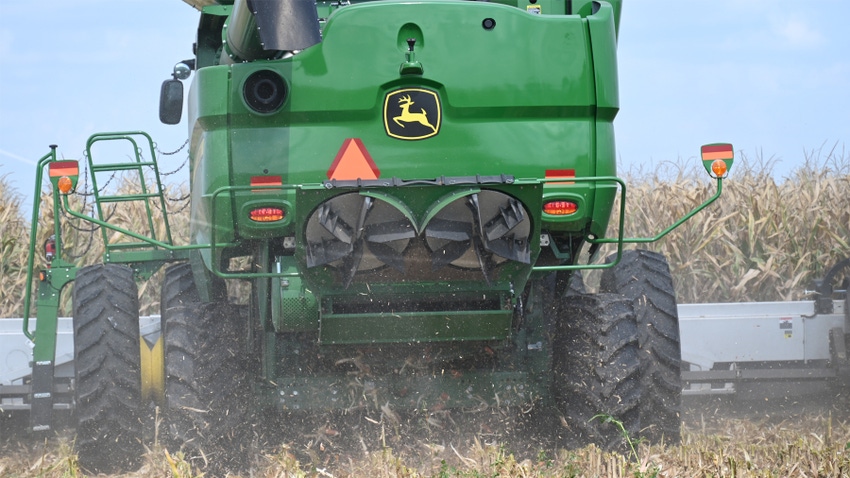A look at over 50 years of combine evolution
Then and Now: The harvesting machines we run through the field these days to bring in the grain have changed a little in the past 56 years.

Three years ago, Phelps County, Neb., farmer Blake Johnson, put his Claas Lexion 8600TT combine to the test. He set out to break a harvesting record with his Class-8 machine, running up to 7,400 bushels an hour in corn that was yielding 265-280 bushels an acre.
When the dust cleared and the last truck had been unloaded, Johnson broke the previous record by about 500 bushels, harvesting an 57,926.76 dry weight bushels in eight hours. That is moving along.
Back to ’60s
That also is why it is fun to look back to our Aug. 17, 1967, issue of Nebraska Farmer and an article, “There’ll be an ‘army’ of harvesters this fall,” covering all of the new features and models of combines available from several different manufacturers of the day.
Those combines from 56 years ago look a little different from Johnson’s Claas Lexion combine — or the John Deere X9, Case IH Axial Flow 250 or 160 series, or New Holland CR7 combines in the field today. But for their time, newer features like having specific controls and settings available from the operator’s seat — or even having a cab at all — were just being offered commercially.

LOOKING BACK: Here are just a few of the new combines being featured in the Aug. 17, 1967, issue of Nebraska Farmer. (Farm Progress)
On a two-page spread in the magazine listing 10 combines, half were without a cab, including the Case 160, Ford 630, Gleaner C-11, International Harvester 315 and the New Holland 990. A John Deere 103, Oliver 531, New Idea Uni-System, Minneapolis Moline 4296 and a Massey Ferguson 205 were featured with cabs in the photos.
Several of these combines cited hydrostatic steering. The Ford 630 touted grain headers up to 16 feet, and three- or four-row corn heads for it. The Gleaner could be equipped with a futuristic-looking eight-row corn head for 20-inch rows, and the John Deere had a six-row corn head for narrow rows. The New Holland 990 could handle headers up to 22 feet. That’s still a far cry from the 60-plus-foot headers available today.
‘New’ features
Ford also promoted that a “single lever on the operator’s deck controls header height, reel height, travel speed and cylinder speed, along with a concave adjustment from the deck.” That sure beats stopping and having to manually adjust.
IHC noted that its 315 came with an optional hydrostatic drive, which was a big deal, allowing change of speed and travel direction without clutching. The John Deere blurb noted that their combines that year had optional hydraulic drive, power steering, and reel speed and height adjustment on the go.
The steering wheel seemed to be a big deal in 1967, because almost all of the combines noted an adjustable steering wheel, with Oliver and Massey-Ferguson making the distinction that their steering wheel columns will tilt and telescope to different positions.
Many farmers also recall the unique New Idea Uni-System that allowed the same power unit to work for a silage cutter, sheller or combine harvester. New Idea noted a new four-row corn head available for its Uni-System combines in 1967, along with a new sheller unit. These included hydrostatic power steering, hydraulic brakes and adjustable steering wheel as standard equipment.
Things have changed
Comparing the older combines to today’s, capacity is the top change, along with the technology, shelling ability, ease of maintenance and automatic adjustments. The IHC 315, for instance, had a 72-hp engine, a cutting width up to 14 feet and a grain tank capacity of 70 bushels. It also could handle a two-row wide corn head or a three-row narrow one.
In contrast, the modern Claas Lexion 8600TT combine used by Johnson to break the harvesting record has 506 hp, with a grain tank capacity well over 425 bushels — and that is just a Class-8 combine.
If we talk about combine operator fatigue, today’s machines have comfortable captain’s seats, visible screen monitors, high visibility glass, air conditioning and heating, and a much more comfortable ride than those combines in 1967.
The open-air combines of that day were more naturally air conditioned and were most likely to have the operator eating grain dust by the bucket loads, taking cornstalks, dirt and chaff in the face on a windy day. High visibility then meant no cab. And even those with cabs were hot on warm days without good ventilation, except for an open door or window.
Times in the combine cab or on the operator’s deck have surely changed, but the basic operations of the machine, shelling grain into a grain tank that can be emptied into a truck or grain wagon, are still somewhat similar. And those new 1967 combines were obviously a step up from the old corn pickers, or going back in time even further: picking corn by hand.
Read more about:
CombinesAbout the Author(s)
You May Also Like





